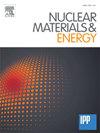西托卡马克高通量运动后的粉尘收集
IF 2.3
2区 物理与天体物理
Q1 NUCLEAR SCIENCE & TECHNOLOGY
引用次数: 0
摘要
对于WEST的第二阶段,较低的导流器完全配备了主动冷却的ITER级等离子体面单元,该单元由钨斜块链制成。在这种配置下,尘埃颗粒是在2023年收集的,在第一次等离子体运动之后,主要是在等离子体附着到分流器的条件下进行重复的长脉冲。由于高颗粒影响和显著的钨侵蚀,产生了大量的粉尘。除了在异常事件中产生的粉尘和典型的托卡马克壁侵蚀沉积物的剥落外,还发现了沉积在斜块阴影区域的纯钨薄层剥落引起的粉尘颗粒。作为特殊的特征,这些薄层可能不粘附在分流器上,因此,在等离子体操作过程中可能被剥离和动员。本文章由计算机程序翻译,如有差异,请以英文原文为准。
Dust collection after the high fluence campaign of the WEST tokamak
For Phase 2 of WEST, the lower divertor was entirely equipped with actively cooled ITER grade plasma-facing units made of chains of tungsten beveled monoblocks. In this configuration, dust particles were collected in 2023, after the first plasma campaign mainly dedicated to repetitive long pulses in the conditions of attached plasmas to the divertor. Due to a high particle fluence and a significant tungsten erosion, large quantities of dust were produced. In addition to those produced during off-normal events and the flaking of deposits which are typical of tokamak wall erosion, dust particles due to the flaking of pure tungsten thin layers deposited on the shadowed areas of beveled monoblocks were found. As specific characteristic, these thin layers may not adhere to the divertor and consequently, may be peeled off and mobilized during plasma operation.
求助全文
通过发布文献求助,成功后即可免费获取论文全文。
去求助
来源期刊

Nuclear Materials and Energy
Materials Science-Materials Science (miscellaneous)
CiteScore
3.70
自引率
15.40%
发文量
175
审稿时长
20 weeks
期刊介绍:
The open-access journal Nuclear Materials and Energy is devoted to the growing field of research for material application in the production of nuclear energy. Nuclear Materials and Energy publishes original research articles of up to 6 pages in length.
 求助内容:
求助内容: 应助结果提醒方式:
应助结果提醒方式:


